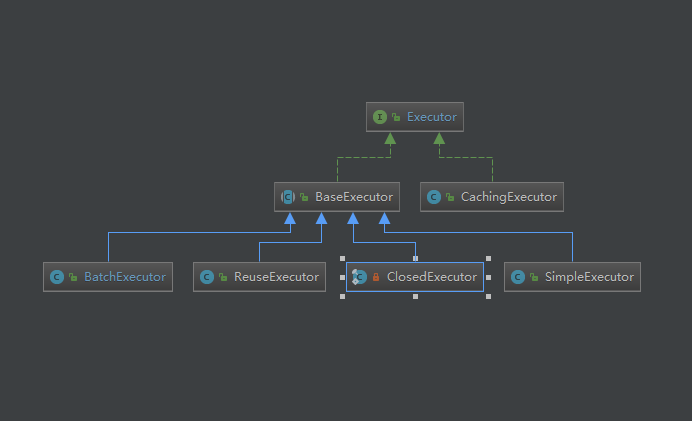1. Executor接口设计与类结构图
public interface Executor {
ResultHandler NO_RESULT_HANDLER = null;
// 执行update,delete,insert三种类型的sql语句
int update(MappedStatement ms, Object parameter) throws SQLException;
// 执行select类型的SQL语句,返回值分为结果对象列表和游标对象
<E> List<E> query(MappedStatement ms, Object parameter, RowBounds rowBounds, ResultHandler resultHandler, CacheKey cacheKey, BoundSql boundSql) throws SQLException;
<E> List<E> query(MappedStatement ms, Object parameter, RowBounds rowBounds, ResultHandler resultHandler) throws SQLException;
<E> Cursor<E> queryCursor(MappedStatement ms, Object parameter, RowBounds rowBounds) throws SQLException;
// 批量执行SQL语句
List<BatchResult> flushStatements() throws SQLException;
// 提交事务
void commit(boolean required) throws SQLException;
// 事务回滚
void rollback(boolean required) throws SQLException;
// 创建缓存中用到的CacheKey对象
CacheKey createCacheKey(MappedStatement ms, Object parameterObject, RowBounds rowBounds, BoundSql boundSql);
boolean isCached(MappedStatement ms, CacheKey key);
// 清空一级缓存
void clearLocalCache();
// 延迟加载一级缓存中的数据
void deferLoad(MappedStatement ms, MetaObject resultObject, String property, CacheKey key, Class<?> targetType);
// 获取事务对象
Transaction getTransaction();
// 关闭Executor对象
void close(boolean forceRollback);
// 检测Executor对象是否关闭
boolean isClosed();
void setExecutorWrapper(Executor executor);
}

简单执行器SimpleExecutor:每执行一次update或select,就开启一个Statement对象,用完立刻关闭Statement对象。(可以是Statement或PrepareStatement对象)
重用执行器ReuseExecutor:执行update或select,以sql作为key查找Statement对象,存在就使用,不存在就创建,用完后,不关闭Statement对象,而是放置于Map<String, Statement>内,供下一次使用。(可以是Statement或PrepareStatement对象)
批量执行器BatchExecutor:执行update(没有select,JDBC批处理不支持select),将所有sql都添加到批处理中(addBatch()),等待统一执行(executeBatch()),它缓存了多个Statement对象,每个Statement对象都是addBatch()完毕后,等待逐一执行executeBatch()批处理的;BatchExecutor相当于维护了多个桶,每个桶里都装了很多属于自己的SQL,就像苹果蓝里装了很多苹果,番茄蓝里装了很多番茄,最后,再统一倒进仓库。(可以是Statement或PrepareStatement对象)
缓存执行器CachingExecutor:装饰设计模式典范,先从缓存中获取查询结果,存在就返回,不存在,再委托给Executor delegate去数据库取,delegate可以是上面任一的SimpleExecutor、ReuseExecutor、BatchExecutor。
无用执行器ClosedExecutor:毫无用处,读者可自行查看其源码,仅作为一种标识,和Serializable标记接口作用相当。
作用范围:以上这五个执行器的作用范围,都严格限制在SqlSession生命周期范围内。
2. 基类BaseExecutor源码解析
它是一个实现了Executor接口的抽象类,实现了接口中的大部分方法,其中就是使用了模板模式,它主要提供了缓存和事物管理的基本功能,不同的实现类,只要实现4个基本方法来完成数据库的相关操作,这4个抽象方法:doUpdate()、doQuery()、doFlushStatement()、doQueryCursor。
源码片段
protected Transaction transaction;// 实现事务的回滚和提交,关闭操作 protected Executor wrapper; // 其中封装的Executor对象 // 延迟加载队列 protected ConcurrentLinkedQueue<DeferredLoad> deferredLoads; // 下面两个属性是一级缓存用到的对象 protected PerpetualCache localCache; protected PerpetualCache localOutputParameterCache; protected Configuration configuration; // 嵌套查询层级 protected int queryStack; private boolean closed;
protected abstract int doUpdate(MappedStatement ms, Object parameter)
throws SQLException;
protected abstract List<BatchResult> doFlushStatements(boolean isRollback)
throws SQLException;
protected abstract <E> List<E> doQuery(MappedStatement ms, Object parameter, RowBounds rowBounds, ResultHandler resultHandler, BoundSql boundSql)
throws SQLException;
protected abstract <E> Cursor<E> doQueryCursor(MappedStatement ms, Object parameter, RowBounds rowBounds, BoundSql boundSql)
throws SQLException;
2.1 SimpleExecutor
@Override
public int doUpdate(MappedStatement ms, Object parameter) throws SQLException {
Statement stmt = null;
try {
Configuration configuration = ms.getConfiguration();
StatementHandler handler = configuration.newStatementHandler(this, ms, parameter, RowBounds.DEFAULT, null, null);
stmt = prepareStatement(handler, ms.getStatementLog());
return handler.update(stmt);
} finally {
closeStatement(stmt);
}
}
@Override
public <E> List<E> doQuery(MappedStatement ms, Object parameter, RowBounds rowBounds, ResultHandler resultHandler, BoundSql boundSql) throws SQLException {
Statement stmt = null;
try {
Configuration configuration = ms.getConfiguration();
StatementHandler handler = configuration.newStatementHandler(wrapper, ms, parameter, rowBounds, resultHandler, boundSql);
stmt = prepareStatement(handler, ms.getStatementLog());
return handler.<E>query(stmt, resultHandler);
} finally {
closeStatement(stmt);//关闭statement对象
}
}
源码很简单,从configuration对象中去材料,交给handler去处理,处理完后,statement对象马上关闭。
2.2 ReuseExecutor
执行器提供了Statement的重用功能,代码片段如下:
// 缓存使用过的Statement对象,key是SQL语句,value是SQL对应的Statement对象 private final Map<String, Statement> statementMap = new HashMap<String, Statement>();
/**
* 准备获取Statement对象
* @param handler
* @param statementLog
* @return
* @throws SQLException
*/
private Statement prepareStatement(StatementHandler handler, Log statementLog) throws SQLException {
Statement stmt;
BoundSql boundSql = handler.getBoundSql();
String sql = boundSql.getSql();
if (hasStatementFor(sql)) {// 检测是否缓存了相同模式的SQL语句所对应的Statement对象
stmt = getStatement(sql);// 从缓存中获取statement对象
applyTransactionTimeout(stmt);// 修改超时时间
} else {
Connection connection = getConnection(statementLog);
stmt = handler.prepare(connection, transaction.getTimeout());
putStatement(sql, stmt);
}
handler.parameterize(stmt);
return stmt;
}
那statement对象是什么时候关闭的呢?当事物提交回滚或者关闭时都需要关闭这些缓存的Statement对象,在BaseExecutor.commit(),rollback(),close()方法中都会掉用doFlushStatement()方法,所以在改方法中实现关闭Statement对象是非常合适。具体如下:
@Override
public List<BatchResult> doFlushStatements(boolean isRollback) throws SQLException {
// 遍历map集合并关闭其中的Statement对象
for (Statement stmt : statementMap.values()) {
closeStatement(stmt);
}
// 清空缓存
statementMap.clear();
// 返回空集合
return Collections.emptyList();
}
2.3 BatchExecutor
BatchExecutor实现了批处理多条SQL语句的功能,需要注意的是在批处理执行SQL语句时,每次向数据库发送的SQL语句条数是有上限,超过上限会抛出异常,所以批量发送SQL语句的时机是很重要的。
其中的核心字段含义如下:
//缓存多个Statement对象,每个Statement对象中都缓存了多条SQL语句 private final List<Statement> statementList = new ArrayList<Statement>(); //记录批处理的结果 BatchResult中通过updateCounts字段(int[])记录每个Statement执行批处理的结果 private final List<BatchResult> batchResultList = new ArrayList<BatchResult>(); // 记录当前执行的SQL语句 private String currentSql; // 记录当前的MappedStatement对象 private MappedStatement currentStatement;
方法实现如下:
@Override
public int doUpdate(MappedStatement ms, Object parameterObject) throws SQLException {
final Configuration configuration = ms.getConfiguration();
final StatementHandler handler = configuration.newStatementHandler(this, ms, parameterObject, RowBounds.DEFAULT, null, null);
final BoundSql boundSql = handler.getBoundSql();
// 本次执行的sql
final String sql = boundSql.getSql();
final Statement stmt;
// 如果当前执行的SQL与上一次执行的SQL相同且对应的MappedStatement对象相同
if (sql.equals(currentSql) && ms.equals(currentStatement)) {
int last = statementList.size() - 1;
// 已经存在Statement,取出最后一个Statement,有序
stmt = statementList.get(last);
applyTransactionTimeout(stmt);
handler.parameterize(stmt);//fix Issues 322
BatchResult batchResult = batchResultList.get(last);
batchResult.addParameterObject(parameterObject);
} else {
// 尚不存在,新建Statement
Connection connection = getConnection(ms.getStatementLog());
stmt = handler.prepare(connection, transaction.getTimeout());
handler.parameterize(stmt); //fix Issues 322
currentSql = sql;
currentStatement = ms;
// 放到statementList缓存
statementList.add(stmt);
batchResultList.add(new BatchResult(ms, sql, parameterObject));
}
// handler.parameterize(stmt);
// 将sql以addBatch()的方式,添加到Statement中(该步骤由StatementHandler内部完成)
handler.batch(stmt);
return BATCH_UPDATE_RETURN_VALUE;
}
需要注意的是sql.equals(currentSql)和statementList.get(last),充分说明了其有序逻辑:AABB,将生成2个Statement对象;AABBAA,将生成3个Statement对象,而不是2个。因为,只要sql有变化,将导致生成新的Statement对象。
缓存了这么多Statement批处理对象,何时执行它们?在doFlushStatements()方法中完成执行stmt.executeBatch(),随即关闭这些Statement对象。
2.4 CachingExecutor
CachingExecutor是一个Executor接口的装饰器,它为Executor对象增加了二级缓存的相关功能。
//委托的执行器对象,可以是SimpleExecutor、ReuseExecutor、BatchExecutor任一一个 private final Executor delegate; //管理使用的二级缓存对像 private final TransactionalCacheManager tcm = new TransactionalCacheManager();
query方法执行的查询操作步骤:
(1)获取BoundSql对象,创建查询语句对应的CacheKey对象,
(2)检测是否开启了二级缓存,如果没有,则指教调用delegate对象的query()方法查询,如果开启了,则继续后面的步骤
(3)检测查询是否包含输出类型的参数,如果是,则报错
(4)调用TransactionalCacheManager.getObject()方法查询二级缓存,如果二级缓存中查找到相应的结果,则直接返回结果。
(5)如果二级缓存没有相应的结果对象,在调用delegate对象的query()方法查询。最后将得到的结果放入
TransactionalCache.entriesToAddOnCommit集合中保存。
@Override
public <E> List<E> query(MappedStatement ms, Object parameterObject, RowBounds rowBounds, ResultHandler resultHandler) throws SQLException {
// (1)
BoundSql boundSql = ms.getBoundSql(parameterObject);
CacheKey key = createCacheKey(ms, parameterObject, rowBounds, boundSql);
return query(ms, parameterObject, rowBounds, resultHandler, key, boundSql);
}
@Override
public <E> List<E> query(MappedStatement ms, Object parameterObject, RowBounds rowBounds, ResultHandler resultHandler, CacheKey key, BoundSql boundSql)
throws SQLException {
Cache cache = ms.getCache();
if (cache != null) {// (2)
flushCacheIfRequired(ms);
if (ms.isUseCache() && resultHandler == null) {
// (3)
ensureNoOutParams(ms, boundSql);
// (4)
@SuppressWarnings("unchecked")
List<E> list = (List<E>) tcm.getObject(cache, key);
if (list == null) {// (5)
list = delegate.<E> query(ms, parameterObject, rowBounds, resultHandler, key, boundSql);
tcm.putObject(cache, key, list); // issue #578 and #116
}
return list;
}
}
// 没有启动二级缓存,只调用底层Executor查询
return delegate.<E> query(ms, parameterObject, rowBounds, resultHandler, key, boundSql);
}